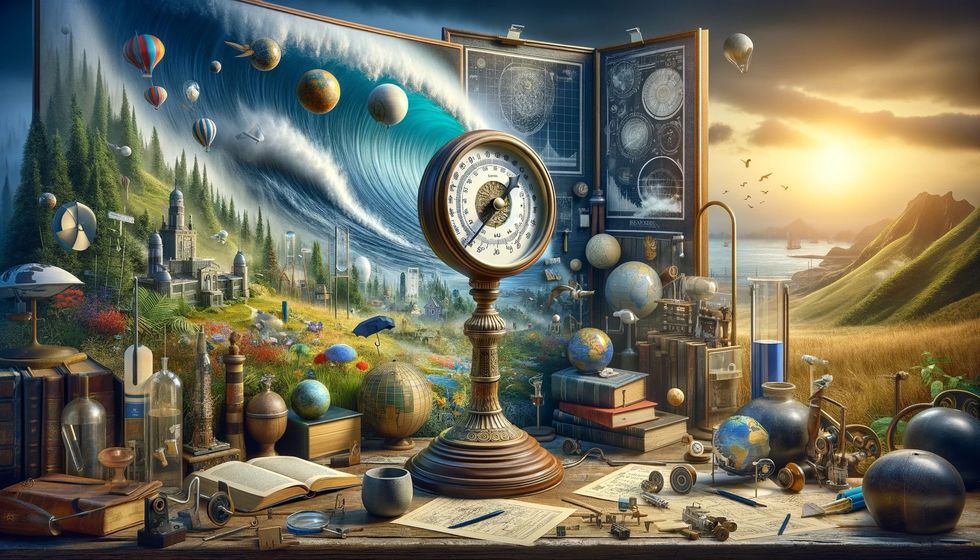Get ready for a gravity-defying twist on quiz night with a collection of physics trivia questions and answers! Physics is the fundamental science that has captivated the minds of many, from aspiring students to Nobel Prize-winning scientists. It explores the nature of the universe, from the smallest particles to the cosmic dance of galaxies.
Whether intrigued by the perplexities of quantum mechanics, the forces that power high voltage power lines, or the dynamics of the solar system, this physics trivia quiz will energize curiosity. So, prepare to delve into the fascinating world of physics.
Will answers fly with the velocity of a rocket or get tangled in the web of wave-particle duality? Find out if the correct answers can be identified as easily as eating food.
Fun Physics Trivia Questions And Answers

Embark on an exhilarating journey through science with a set of fun physics trivia designed to test knowledge and wits. Each question hides a correct answer, waiting to be uncovered like a hidden gem.
These physics trivia challenges are not only about finding the right response but also about revealing the joy and fascination that come with understanding the forces and laws that shape the everyday world.
1. Question: Which Renaissance scientist is credited with the discovery of the pendulum?
Answer: Galileo Galilei.
2. Question: What name is given to the science of sound?
Answer: Acoustics.
3. Question: Name the SI unit of mass.
Answer: Kilogram (kg).
4. Question: What is the name of Isaac Newton's three extremely important laws?
Answer: Law of Inertia, Law of Acceleration, Law of Action and Reaction.
5. Question: Name the instrument used to measure gas pressure.
Answer: A manometer.
6. Question: Which physicist is more famous for his cat than for his equation?
Answer: Erwin Schrodinger.
7. Question: Can you name the tube used to produce X-rays?
Answer: X-ray tube.
8. Question: Name one of the four fundamental forces that physicists talk about in the world of Physics.
Answer: Gravity.
9. Question: What is a word used to describe a solid whose arrangement of atoms and molecules has no definite pattern?
Answer: Amorphous.
10. Question: Name the phenomenon that causes a change in pitch or frequency of a sound when a source is moving towards or away from an observer.
Answer: Doppler effect.
11. Question: How are X-rays different from gamma rays in radiation therapy?
Answer: Their origin.
12. Question: Which quantum mechanics principle posits that determining a particle's position with greater precision results in less accuracy in knowing its momentum?
Answer: The Heisenberg Uncertainty Principle.
13. Question: What is the only natural satellite of Earth?
Answer: The Moon
14. Question: In the metric system, what is the SI unit used to measure electrical power?
Answer: Watt (W).
15. Question: What is the most recognized model of the atom?
Answer: The Bohr model.
16. Question: What force holds protons and neutrons together in the nucleus of an atom?
Answer: The strong nuclear force.
17. Question: Why do distant galaxies appear red-shifted?
Answer: Because they are moving away due to the expansion of the universe.
18. Question: What does the acronym 'LASER' stand for?
Answer: Light Amplification by Stimulated Emission of Radiation.
19. Question: In an electric circuit, what is the main function of the earth wire?
Answer: To protect against electric shock by providing a low-resistance path to the ground.
20. Question: Which famous physicist is credited with the equation E=mc²?
Answer: Albert Einstein.
21. Question: How do cell phones communicate with each other?
A: By sending and receiving radio waves.
22. Question: What is the only planet in our solar system not named after a Greek or Roman god?
Answer: Earth.
23. Question: What is the primary energy source for hydroelectric power?
Answer: Moving water.
24. Question: In physics, what does the term 'centripetal force' refer to?
Answer: The force that causes an object to follow a curved path.
25. Question: According to the Big Bang theory, how did the universe begin?
Answer: With a massive expansion from a singularity.
26. Question: In the Imperial system, how many centimeters are in an inch?
Answer: 2.54 cm (25.4 mm).
Particle Physics Trivia Questions And Answers
Step into the subatomic arena where the building blocks of the universe reveal their secrets. Particle physics trivia questions and answers invite enthusiasts and curious minds alike to unlock the mysteries of matter and energy at their most fundamental level.
Test your knowledge of the intricacies of the standard model, the interactions defined by elusive forces, and the breakthrough discoveries that continue to shape the understanding of the cosmos.
27. What are some of the smallest known subatomic particles?
Answer: Quarks, electrons, and neutrinos.
28. What are the six types of quarks?
Answer: Up, down, charm, strange, top, and bottom.
29. What is the Higgs boson, and why is it important?
Answer: The Higgs boson is a particle that gives other particles their mass, confirming the Standard Model of particle physics.
30. What are the four fundamental forces of nature?
Answer: Gravity, electromagnetism, the strong nuclear force, and the weak nuclear force.
31. What is the difference between a fermion and a boson?
Answer: Fermions have half-integer spin and follow the Pauli exclusion principle, while bosons have integer spin and can occupy the same quantum state.
32. What is the name of the particle accelerator at CERN, where the Higgs boson was discovered?
Answer: The Large Hadron Collider (LHC).
33. What is antimatter?
Answer: Antimatter is composed of antiparticles, which have the same mass as their corresponding particles but opposite charges and quantum numbers.
34. What is the Standard Model of particle physics?
Answer: The Standard Model is a theory that describes three of the four fundamental forces (excluding gravity) and classifies all known elementary particles.
35. What is the difference between a lepton and a hadron?
Answer: Leptons are elementary particles that are not composed of quarks, while hadrons are particles made of two or more quarks.
Surprising Physics Trivia Questions And Answers

Prepare to have your mind bent with some shocking truths from the world of physics. Get ready for a quiz filled with astounding facts that might just defy expectations of how the world operates.
The universe is governed by principles and phenomena that scientists have painstakingly uncovered over centuries, yet they still have the power to surprise and amaze even the most knowledgeable individuals.
36. Question: Can you state the term used to describe an orbit's farthest point from Earth?
Answer: Apogee.
37. Question: What is the main function of a capacitor?
Answer: It is a device that stores electrical energy.
38. Question: For what discovery did Albert Einstein win his first Nobel prize?
Answer: The photoelectric effect.
39. Question: Which is the main type of electromagnetic radiation that is emitted when a copper plate is heated to 100 degrees centigrade?
Answer: Infrared radiation.
40. Question: Upon what two factors are the amount of kinetic energy of an object dependent?
Answer: Mass and velocity.
41. Question: The discovery of infrared radiation is credited to whom?
Answer: William Herschel.
42. Question: What is the name of the powerful process that breaks atoms apart and gives us energy?
Answer: Nuclear fission.
43. Question: In which branch of physics do scientists study the tiniest particles, like atoms and photons?
Answer: Quantum physics.
44. Question: Can you state the year in which Max Planck introduced his quantum theory to science?
Answer: 1900.
Physics Cool Facts Questions And Answers

Fasten your seatbelts and prepare for a whirlwind tour through some of the coolest and most awe-inspiring tidbits that physics has to offer. Discover what makes the universe tick in ways that textbook equations can't fully convey.
From the quirks of particles at the quantum level to the enigmatic behaviors of black holes, get ready to elevate understanding with a collection of cool facts that showcase physics in a whole new light.
45. Question: What is the force that allows an object submerged in a fluid to rise to the top of a container?
Answer: Buoyant force.
46. Question: The hypothesis that all matter exists out of particles was first formulated by whom?
Answer: Leucippus and his pupil Democritus.
47. Question: What is the term 'velocity' defined?
Answer: Velocity is a measure of speed in a given direction.
48. Question: Who developed an equation that relates momentum and wavelength?
Answer: Louis de Broglie.
49. Question: What is the name of the unit of the optical power of a lens?
Answer: Dioptre.
50. Question: For what discovery did Karl Manne Georg Siegbahn win a Nobel Prize in 1924?
Answer: X-ray spectroscopy.
51. Question: What is the SI unit of heat?
Answer: Joules.
52. Question: What is the term used to describe the bending of a light ray when it passes between materials of different densities?
Answer: Refraction.
53. Question: Which scientist discovered the photoelectric effect in 1887?
Answer: Heinrich Rudolf Hertz.
54. Question: What is emitted by the hot metal filament in a cathode ray tube?
Answer: Electrons.
55. Question: Can you name the phenomenon of white light that is responsible for a CD's colorful look when exposed to light?
Answer: Diffraction.
56. Question: Can you name the instrument used to communicate by light?
Answer: Heliograph.
57. Question: Approximately how long does it take for light to travel from the Sun to the Earth?
Answer: Eight minutes and 20 seconds.
58. Question: What is the name of the law that describes how the volume of a specific amount of gas inversely changes with its pressure, provided the temperature remains unchanged?
Answer: Boyle's Law.
59. Question: What causes the Aurora Borealis (also known as the Northern Lights)?
Answer: Electrical particles from the Sun hitting the Earth's atmosphere.
60. Question: Which scientist worked on the basic principle for generating an electric current?
Answer: Michael Faraday.
61. Question: The quality of a sound wave depends on what?
Answer: The shape of the waveform.
62. Question: In which century was physics discovered?
Answer: The fourth century BCE.
63. Question: What are the five main laws of physics?
Answer: Law of Universal Gravitation, Newton's Laws of Motion, Law of Conservation of Mass, Law of Conservation of Energy, Law of Thermodynamics.
64. Question: Who is the most famous physicist?
Answer: Arguably, Albert Einstein.
65. Question: Which scientist discovered the phenomenon of superconductivity?
Answer: Kamerlingh Onnes.
66. Question: After which famous scientist's name is the unit of the electric current named?
Answer: André-Marie Ampère.
67. Question: For what is a Pitot tube used for?
Answer: Measuring the velocity of flowing fluids.
68. Question: When you jump up, what is the invisible force that pulls you back down to the ground called?
Answer: Gravitational force.
69. Question: Who was the famous scientist who discovered the law of gravity when an apple fell on his head, and gave us three laws theory of motion that we still use in physics today?
Answer: Isaac Newton.
70. Question: What is sometimes called the language of physics?
Answer: Mathematics.
71. Question: What is Robert Oppenheimer known as in the world of physics?
Answer: Father of the atomic bomb.
72. Question: What is the name of the tiny particles that make up everything in the universe and are often called the building blocks of matter?
Answer: Atoms.
73. Question: What is the term used to describe the behavior of supposed alien aircraft that seems to defy the laws of physics?
Answer: Anti-gravity.
74. Question: What branch of physics studies motion and the forces that cause it?
Answer: Classical mechanics.
75. Question: Which color of visible light has the shortest wavelength?
Answer: Blue light.
FAQs

How can I measure electrical power in my home appliances?
Electrical power is typically measured in watts. To measure the power consumption of an appliance, you can use a watt-meter or look at the appliance's specification label for its power rating, and then use that figure to calculate energy usage over time.
What is the significance of the moon being Earth's only natural satellite?
The moon's gravitational influence is a major factor in Earth's climate and tides. Its presence also aids in stabilizing the planet's axial tilt, which is important for sustaining seasons and climate patterns.
Why do physicists study things like quantum mechanics and particle physics?
Physicists study quantum mechanics and particle physics to understand the universe's fundamental laws and components. By exploring these fields, they can unravel the mysteries of how particles interact at the smallest scales, which has implications for understanding the entire cosmos's structure and behavior.
How does quantum physics differ from classical physics?
Quantum physics differs from classical physics in that it focuses on the behavior and interactions of particles at the smallest scales, such as atoms and subatomic particles. It involves principles like uncertainty, superposition, and entanglement, which do not have counterparts in classical physics.
Classical mechanics, by contrast, deals with the macroscopic world and is governed by Newton's laws of motion.
Fueled by curiosity and armed with new insights, navigation through puzzles of classical mechanics has occurred, secrets of quantum physics have been unlocked, and the sound barrier has soared past!
Whether correctly answering how many centimeters make up a meter or how atomic bombs work, each question has led you closer to understanding the incredible laws that govern the universe.
Congratulations on completing the physics trivia quiz, it has been proved that physics can be just as entertaining as it is enlightening!
Related Articles Around the Web













